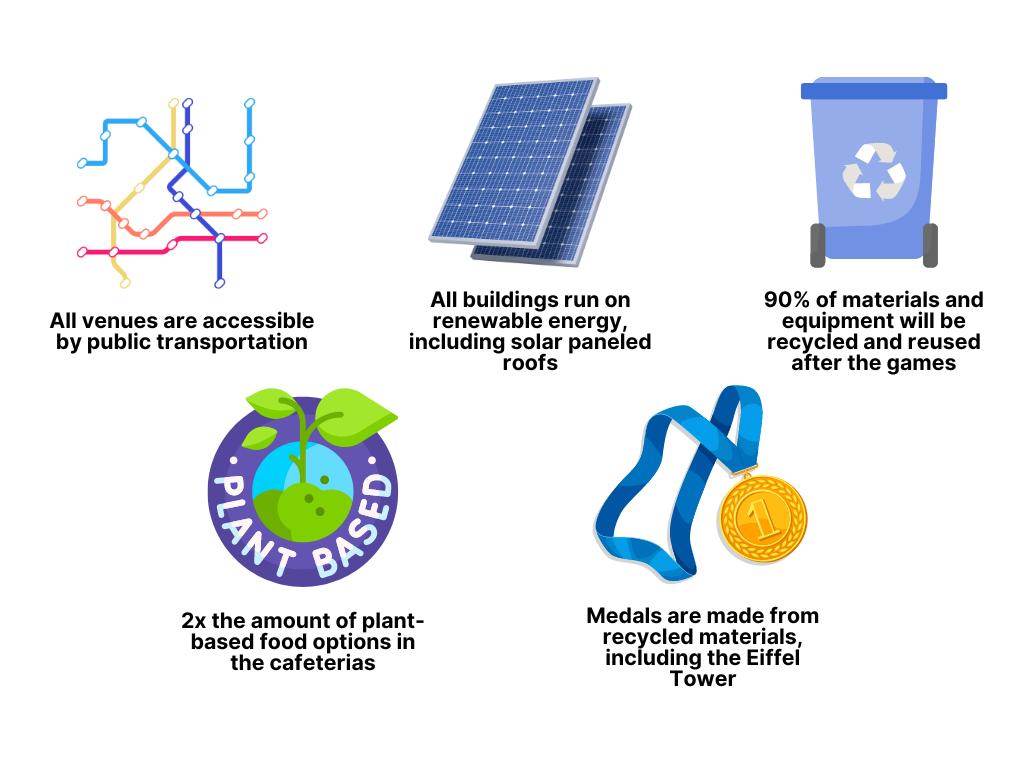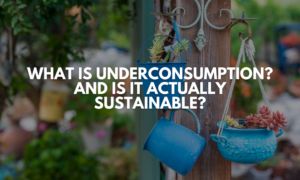The Paris 2024 Olympics are well under way, as they kicked off last Friday, July 26th. An incredible city in and of itself, after winning the bid to host the 2024 Olympic Games, Paris made a commitment to making this the most sustainable Olympics to date.
While some call their efforts “greenwashing,” it’s important to acknowledge just how far the sustainability gap between Paris 2024 and its predecessors has come and how widespread this year’s efforts actually went.
Let’s take a look at 5 innovative strides Paris took to reduce the overall carbon footprint for this year’s Olympic games.
Paris 2024 Venues
Here are the facts:
- 95% of the venues used for competition were pre-existing or temporary
- Paris set a goal to not exceed 1.58 million tonnes of carbon dioxide which boasts a footprint half that of the London 2012 or Rio 2016 games
- Only 4 new buildings were constructed from scratch for this year’s games including a new Aquatics centre, gymnastics and badminton facilities, as well as the Olympic Village
Not only were these venues made with sustainability features to encourage longevity and decreased greenhouse gas emissions, they were built with the Parisian community in mind. All 4 of the newly built facilities sit in the heart of the Seine-Saint-Denis suburb, an under-invested area outside of the larger city. These new builds aim to invest new resources into a community that could use some support.
For example, the state of the art Aquatics Centre will remain standing after the games end to teach the large number of children in the area who don’t know how to swim. Beyond that, it will serve as an example of reusable energy, recyclable materials, and increased biodiversity through the planting of over 100 new trees.
In another sustainable move, every single venue was made accessible through public transportation to decrease the usage of fuel and diesel to get there. Additionally, 88 km (54.7 miles) of bicycle lanes were added to the 418 km (259.7 miles) that were already in place, making Paris as a whole more bicycle friendly even beyond the closing ceremony.
Renewable Energy
In addition to the brand new facilities, all of the temporary and pre-existing venues have been connected through a grid to run on solar panels and renewable energy. Advancements in cooling have also been made to the Olympic Village and other facilities by implementing geothermal methods of cooling instead of traditional air conditioning.
To Reuse & Recycle
What’s going to happen to all the materials used to make the temporary facilities once the games are over? Paris has committed to giving 90% of material, equipment, and goods used, a second life post-Olympics. Not only that, but all the newly built construction were bio-sourced, used recycled materials, and designed roof structures that support natural cooling and heating methods.
Back in the initial conversations surrounding how to make the Paris Games as sustainable as possible, the committee chose to align itself within the goals of the Paris Agreement. One of the biggest goals outlined in the strategy was to support the implementation of a circular economy. By allowing for materials to reenter the economy in new forms after the competitions, there will be significantly less waste and carbon emissions that enter the atmosphere.
Food
Olympic athletes require large diets to keep up with the amount of energy they expend in training and in their actual events. One of the biggest opponents of reaching net-zero in carbon emissions is the distribution of single-use plastic. Luckily, for the athletes and spectators, the games will see a 50% reduction in single-use plastics, and instead encourage reusable options.
Additionally, in the cafeteria, there are twice the amount of plant-based food options available as well as locally sourced Parisian options.
Olympic Medals
Last but not least, in one of the most innovative moves, the actual gold medals for the Olympic winners will be made from pieces of the Eiffel Tower. Not only is using the iron a sustainable option by using resources already available, you also get to take a piece of Paris with you when you leave. The silver and bronze medals will also be made sustainably using copper, tin, and zinc alloys in the metal scraps from coin factories in France.
While the Olympics still have a long way to go in becoming a carbon neutral event, making significant strides in the construction, reuse, and recycling of materials, food, and energy is a powerful first step.
Paris 2024 has set the stage for the Milan-Cortina d’Ampezzo 2026, Los Angeles 2028, French Alps 2030, Brisbane 2032, and Salt Lake City 2034 games within the next 10 years. The expectations for continued reduction in carbon emissions will only increase, so all eyes will be on these locations to see how they create a more sustainable Olympic experience.
Want to learn more about sustainability?
Have you followed us on social media?
To download our app, check out our Linktree!
About EnviroStaff
EnviroStaff is a division of LGC that focuses on making placements in the environmental industry. We build partnerships with clients to fill open positions on their team and have recruiting capabilities within multiple markets throughout the U.S. Working closely together, EnviroStaff will recruit environmental industry professionals based on your job description and requirements. By making direct hire placements, EnviroStaff can help clients save time and money often associated with recruiting.






